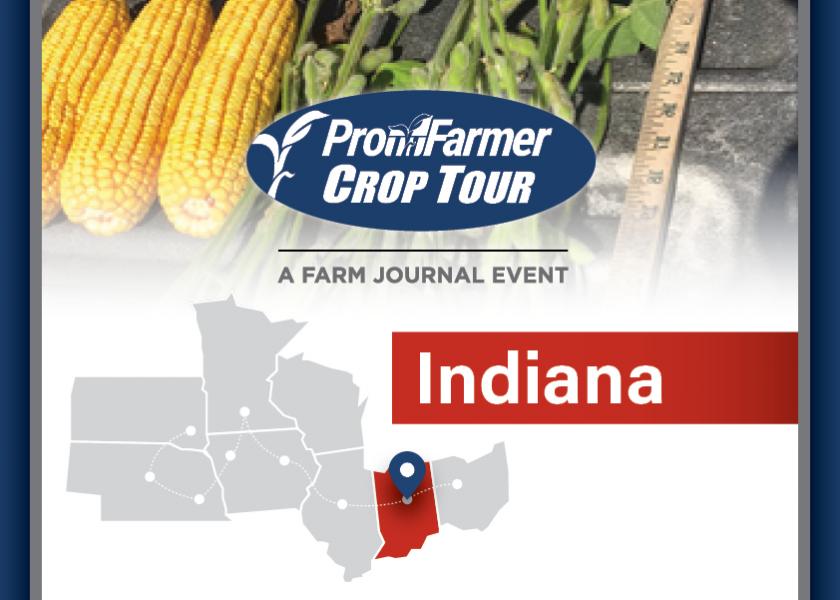Crops Continue to Impress in Indiana While Dryness Takes a Toll on Portions of Nebraska

Pro Farmer Crop Tour started off on a high note in Ohio this year. The Eastern Corn Belt crop impressed scouts and tour leads Monday as the Ohio crop averaged 185.1 bu. per acre on tour routes, up from 167.7 bu. in 2020. South Dakota’s crop is more disappointing, as scouts described, at 151.5 bu. per acre, down from 179.2 bu. last year.
Vigorous Start in Indiana
As scouts entered fields in Indiana on Tuesday, the high expectations for the Eastern Corn Belt were reaffirmed.
“We’ve taken eight samples so far on my route, and boy, it’s been rock solid,” said Brian Grete, Pro Farmer editor, on AgriTalk. “We had a low of 182.7 bu. per acre and a high of 256.5. All but two of the first eight samples we’ve taken have been 200 [bu. per acre] or above.”
A vigorous start to the year was evident as Grete and other scouts collected samples in Indiana corn and soybean fields. However, a recent turn to drier conditions has some concerned about a strong finish this year.
“They started out really, really strong here. There are some drier areas; it was notably drier on some of the samples we pulled. So, it has potential to go backward from where it’s at right now, but it’s holding on,” Grete said.
Grete, who is managing the east leg of the Pro Farmer Crop Tour, says three weeks ago, Indiana farmers were possibly looking at their best crop ever. But as dryness concerns set in, it’s slightly lowered expectations in some areas of the state, particularly around Logansport.
“What we’re dealing with is how many of the kernels on the tip will remain viable and turn into grain, and how many will be aborted and you get that tip back if it does get dry. They need to catch a shower. Some of the areas are wet so apparently they did get some rain overnight, but it’s notably drier than what we saw yesterday and the early part this morning,” Grete said.
In 10 stops in IN crop districts 5, 2 & 1, my route had an average corn yield of 202.9. Range of 176.5 to 256.6. It was dry, but this area had what appears to be a great start and are holding on. #PFtour21 — Brian Grete (@BGrete) August 17, 2021
"Keep in mind, we’re one of 11 routes, so we’ll see what the data is when it comes in at the end of the day when all the routes are in,” he added. “They’ve got a great crop out in the field, it's a matter of how much they hold on to at this point in time and how the crop finishes up.”
Irrigated Soybeans Shine in Nebraska
Dryness continues to be an issue for Nebraska, with 82% of the state experiencing dryness, according to the latest U.S. Drought Monitor. While most of the state is abnormally dry, nearly 40% is looking at moderate drought conditions.
“The offsets are out there in Nebraska,” said Chip Flory on AgriTalk Tuesday. “It’s not the consistency Brian has seen in Ohio and Indiana this week. Today we’re making our way over to Nebraska City where the dryland corn is really starting to show the stress.”
Irrigated fields are a different story, as Flory said corn to soybean are producing big yields.
“I'm in the southeast part of the state now, and I was in irrigated beans today that made me a little nervous when I was walking into them because they were about armpit high,” Flory said. “I’ve been in those fields before where they look awesome from the road but when you walk into them, all of a sudden, you pull plants and there are 10 pods per plant. That was not the case in these beans. I felt like I was in legitimate 70 bushel [per acre] beans. Keep in mind that’s one irrigated field on one route.”
2 stops in Adams Co NE on #PFtour21 with @SDSUExtCrops and found some nice beans. 1528.80 and 1610.40 in a 3’ x 3’. pic.twitter.com/U5RP7FGhR1 — HogPharm ? ???? (@PigPharm) August 17, 2021
A lack of disease pressure is also a bright spot for the Nebraska crop this year, but one concern is beginning to sprout.
“The fields really look pretty clean right now, but I just wonder what it’s going to look like in a couple of weeks because there’s some gnarled up waterhemp under the canopy that survived another dose and it may be ready to break through in the next couple of weeks,” Flory said. “It could reveal some of the weed issues that are out there. It’s not in every field, but it’s something we noticed.”
The Nebraska & Indiana results will be announced tonight. Sign up for our exclusive reports & historical comparisons: https://t.co/iieuxrQgYu #pftour21 pic.twitter.com/wOxqNs7S9A — Pro Farmer (@profarmer) August 17, 2021






